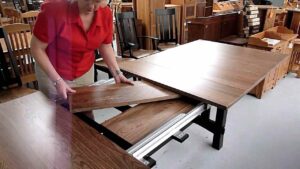Embarking on the journey to declutter your home is a transformative endeavor, one that transcends mere tidiness to embrace a holistic approach toward a more organized and serene living space. This step-by-step guide is crafted to navigate you through the intricacies of decluttering, focusing on effective techniques, personalized plans, and the integration of professional furniture removal services. By understanding the psychological benefits, streamlining furniture choices, and adopting sustainable practices, this guide not only revitalizes your immediate surroundings but also cultivates habits for enduring order. Join us on this insightful journey toward a clutter-free home that enhances not only your physical space but also your overall well-being. Dive into the intricacies of decluttering as we explore how to identify and address clutter hotspots within each room, offering practical tips for sorting and organizing belongings. Discover the synergy between furniture choices and an organized home, emphasizing quality pieces that enhance both functionality and aesthetics. The guide advocates for eco-friendly practices, guiding you on responsible disposal and donation options. Real-life success stories and frequently asked questions provide a well-rounded understanding of the decluttering process. To make this journey seamless, consider A&B Junk, our featured service provider, for efficient furniture removal, ensuring a stress-free transformation of your living space.
Unveiling Tranquility: A Comprehensive Guide to Decluttering Your Home with Professional Furniture Removal Services
Embark on a journey to reclaim serenity within your home with our step-by-step guide. Join forces with A&B Junk for seamless furniture removal, as we guide you through the art of decluttering and transforming your living space into an organized haven.

Understanding the Benefits of Decluttering: A Prelude to a Tidier Home
Decluttering is not just about creating a visually appealing space; furniture removal services has profound psychological and emotional benefits as well. This heading delves into the reasons behind decluttering, emphasizing the positive impact on mental well-being, stress reduction, and improved focus. By highlighting the connection between an organized living environment and overall happiness, readers are encouraged to approach the decluttering process with a deeper understanding of its potential transformative effects on their lives.
Assessing Your Living Spaces: Identifying Clutter Hotspots
The first practical step in any decluttering journey is to identify and assess clutter hotspots within your home. This section guides readers through a room-by-room analysis, helping them pinpoint areas that tend to accumulate the most clutter. By identifying these trouble zones, individuals can create a targeted and efficient decluttering plan. This involves evaluating the purpose of each space, determining which items are essential, and recognizing those that are no longer serving a useful function. The goal is to provide readers with a strategic approach to decluttering that addresses specific areas of their home, making the process more manageable and focused.
Crafting a Personalized Decluttering Plan: Room-by-Room Approach
Once clutter hotspots are identified, this section guides readers through the process of creating a personalized decluttering plan. Each room may require a unique strategy based on its purpose and the type of items stored within. The step-by-step approach encourages readers to set realistic goals, prioritize areas that need immediate attention, and establish a timeline for completing the decluttering process. By tailoring the plan to their specific living spaces, individuals are more likely to stay motivated and achieve lasting results.
Effective Decluttering Techniques: Sorting, Donating, and Discarding
This segment provides practical tips on the actual decluttering process. Readers learn effective techniques for sorting through belongings, deciding what to keep, donate, or discard. Emphasis is placed on making conscious choices to minimize possessions and create a more intentional living space. The section also addresses common challenges such as sentimental attachments and offers guidance on how to overcome emotional barriers to decluttering effectively.
Maximizing Storage Solutions: Organizational Tips for a Neat Space
With the excess removed, this part focuses on optimizing storage solutions to maintain an organized and clutter-free environment. Readers are introduced to creative storage ideas, such as utilizing underutilized spaces, investing in multifunctional furniture, and implementing storage solutions that align with their lifestyle. By emphasizing practical and visually appealing organization methods, individuals are encouraged to integrate sustainable habits that prevent clutter from accumulating in the future.
Streamlining Furniture Choices: Optimal Pieces for a Clutter-Free Home
This section explores the connection between furniture choices and a clutter-free home. It provides guidance on selecting furniture that not only complements the overall design but also serves a functional purpose, promoting an uncluttered and open living space. Emphasizing quality over quantity, readers are encouraged to invest in pieces that contribute to a sense of spaciousness and ease of movement within their homes.
Hiring Professional Help: Exploring Furniture Removal Services
Recognizing that decluttering can be a daunting task, this section introduces the option of hiring professional furniture removal services. It explores the benefits of seeking assistance, such as saving time and reducing the physical and emotional burden of the decluttering process. Readers learn how to research and choose reliable services, ensuring a seamless and stress-free experience.
Eco-Friendly Decluttering: Sustainable Disposal and Donation Options
As sustainability becomes increasingly important, this heading educates readers on eco-friendly decluttering practices. It discusses responsible disposal methods, recycling options, and how to choose donation centers that align with environmental values. By incorporating eco-conscious choices into the decluttering process, individuals contribute to reducing waste and minimizing their ecological footprint.
Maintaining a Clutter-Free Home: Habits for Long-Term Organization
Building on the momentum of a freshly decluttered space, this section offers guidance on establishing habits to maintain long-term organization. Readers learn about daily routines, cleaning schedules, and mindfulness practices that contribute to an ongoing clutter-free lifestyle. By fostering a mindset of continuous organization, individuals are empowered to sustain the benefits of decluttering over time.

Celebrating Your Decluttered Space: Transformative Before-and-After Success Stories
The final section serves as a motivational conclusion, showcasing real-life success stories of individuals who have transformed their living spaces through decluttering. By highlighting the positive impact on their lives, this section inspires readers to appreciate and celebrate their own achievements. Encouraging a sense of accomplishment, it reinforces the idea that a decluttered home is not only visually pleasing but also a source of pride and improved well-being.
FAQs
Why is decluttering important for my home?
Decluttering is crucial for mental clarity and a more organized living space. It reduces stress, increases productivity, and creates a visually appealing environment.
How can I choose the right furniture removal service?
Research local services, read reviews, and ensure they are licensed and insured. Obtain quotes and inquire about their eco-friendly disposal practices for a responsible choice.
What are some quick decluttering tips for busy individuals?
Start small, focus on one area at a time, and set achievable goals. Consider enlisting professional help for faster results.
How can I maintain a clutter-free home after decluttering?
Establish daily routines, designate specific spaces for items, and avoid unnecessary purchases. Consistency is key to sustaining an organized environment.
Can decluttering be environmentally friendly?
Yes, opt for sustainable disposal methods, recycle items when possible, and donate to eco-conscious organizations. Make environmentally responsible choices throughout the decluttering process.
Conclusion
In conclusion, embarking on the journey of decluttering your home with the assistance of a step-by-step guide and furniture removal services promises transformative results. Beyond the aesthetic appeal of an organized living space, this holistic approach addresses the psychological benefits of reducing stress and fostering a sense of well-being. By crafting a personalized decluttering plan, embracing effective techniques, and exploring sustainable disposal options, individuals not only reclaim their physical spaces but also cultivate habits for enduring order. The inclusion of professional furniture removal services offers a convenient and efficient solution, highlighting the importance of seeking assistance for a seamless and stress-free decluttering experience. Ultimately, celebrating the achievements and maintaining a clutter-free home becomes a source of pride, enhancing the overall quality of life. The guide emphasizes the significance of understanding clutter hotspots, streamlining furniture choices, and maximizing storage solutions. It advocates for an eco-friendly approach, promoting responsible disposal and donation options. The incorporation of real-life success stories reinforces the positive impact of decluttering on individuals’ lives. As readers navigate through each step, they are encouraged to adopt sustainable practices, creating a lasting and harmonious living environment. The inclusion of frequently asked questions addresses common concerns, offering concise solutions for a quick and effective understanding of the decluttering process. Overall, this comprehensive guide empowers individuals to not only declutter their homes but also embrace a mindful and intentional lifestyle, fostering enduring benefits for their well-being.




